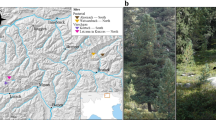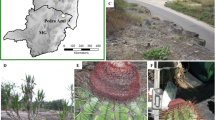Abstract
Fungal endophytes were collected from 168 Pinus halepensis trees sampled in 55 Spanish stands. In total, 229 endophytic isolates were grouped into 92 morphotypes according to their mycelium features. Thus, twigs enclosed 63.76% of the total endophyte isolates and needles 36.24%. Likewise, twig samples also yielded a higher endophyte species richness. Analysis of ITS rDNA region generated 38 different Ascomycota taxa and confirmed the endophytic stage of several pathogens previously associated with the Pinus halepensis decline in Spain. Naemacyclus minor, Brunchorstia pinea, Lophodermium pinastri, Phomopsis sp., Diplodia pinea, Pestalotiopsis besseyi and Truncatella angustata were isolated. Sequencing of LSU rDNA region verified the 38 taxa and contributed to infer their phylogenic relatedness using the Neighbour-Joining method. In the bootstrap consensus tree five classes were observed. Dothideomycetes resulted to be the dominant class because of its high isolation frequency (52.4%) and richest species composition (39.5%). On the contrary, class Eurotiomycetes was the least abundant (3.5%) and along with class Pezizomycetes harboured the lowest species richness (7.9%). Class Sordariomycetes and Leotiomycetes had intermediate abundance and species composition percentages. This study represents the first work concerning the taxonomy of the fungal endophytic community of the Mediterranean host species Pinus halepensis using molecular tools. The data provided here may help to establish the cause of Pinus halepensis decline.

Similar content being viewed by others
References
Abelló MA (1998) Historia y Evolución de las Repoblaciones Forestales en España. Universidad Complutense de Madrid, Madrid, p 749
Albrectsen B, Björkén L, Varad A, Hagner Å, Wedin M, Karlsson J, Jansson S (2010) Endophytic fungi in European aspen (Populus tremula) leaves—diversity, detection, and a suggested correlation with herbivory resistance. Fungal Divers 41:17–28
Arnold AE (2007) Understanding the diversity of foliar endophytic fungi: progress, challenges, and frontiers. Fungal Biol Rev 21:51–66
Arnold AE, Herre EA (2003) Canopy cover and leaf age affect colonization by tropical fungal endophytes: ecological patterns and process in Theobroma cacao (Malvaceae). Mycologia 95:388–398
Arnold AE, Maynard Z, Gilbert GS, Coley PD, Kursar TA (2000) Are tropical fungal endophytes hyperdiverse? Ecol Lett 3:267–274
Arnold AE, Henk DA, Eells RL, Lutzoni F, Vilgalys R (2007) Diversity and phylogenetic affinities of foliar endophytes in loblolly pine inferred by culturing and environmental PCR. Mycologia 99:185–206
Baayen RP, Bonants PJM, Verkley G, Carroll GC, van der Ha A, Weerdt M, van Brouwershaven IR, Schute GC, Maccheroni W, de Blanco GC, Azevedo JL (2002) Non pathogenic isolates of the citrus black spot fungus, Guignardia citricarpa, identified as cosmopolitan endophyte of woody plants, G. mangiferae (Phyllosticta capitalensis). Phytopathology 92:464–477
Berbee ML, Taylor JW (2001) Fungal molecular and geologic time. In: McLaughlin DL, McLaughlin EG, Lemke PA (eds) Systematics and evolution. Springer-Verlag, Berlin
Bills GF (1996) Isolation and analysis of endophytic fungal communities from woody plants. In: Carris LM, St Paul MN, Redlin SC (eds) Endophytic fungi in grasses and woody plants. APS, USA, pp 31–65
Botella L, Santamaría O, Díez JJ (2010) Fungi associated with the decline of Pinus halepensis in Spain. Fungal Divers 40:1–11
Cai L, Hyde KD, Taylor PWJ, Weir BS, Waller J, Abang MM, Zhang JZ, Yang YL, Phoulivong S, Liu ZY, Prihastuti H, Shivas RG, McKenzie EHC, Johnston PR (2009) A polyphasic approach for studying Colletotrichum. Fungal Divers 39:183–204
Câmara MPS, Palm ME, van Berkum P, O’Neill NR (2002) Molecular phylogeny of Leptosphaeria and Phaeosphaeria. Mycologia 94:630–640
Carroll G (1988) Fungal endophyte in stems and leaves: from latent pathogen to mutualistic symbiont. Ecology 69:2–9
Carroll G, Müller E, Sutton BC (1977) Preliminary studies on the incidence of needle endophytes in some European conifers. Sydowia 29:87–103
Felsenstein J (1985) Confidence limits on phylogenies: an approach using the bootstrap. Evolution 39:779–783
Fisher PJ, Petrini O, Sutton BC (1993) A comparative study of fungal endophytes in leaves, xylem and bark of Eucalyptus in Australia and England. Sydowia 45:338–345
Freeman S, Rodríguez RJ (1993) Genetic conversation of a fungal pathogen to nonpathogenic, endophtic mutualist. Science 260:75–78
Fröhlich J, Hyde KD, Petrini O (2000) Endophytic fungi associated with palms. Mycol Res 104:1202–1212
Ganley RJ, Newcombe G (2006) Fungal endophytes in seeds and needles of Pinus monticola. Mycol Res 110:318–327
Gardes M, Bruns TD (1993) ITS primers with enhanced specificity of basidiomycetes: application to the identification of mycorhizae and rust. Mol Ecol 2:113–118
Gil L, Díaz-Fernández PM, Jiménez MP, Roldán M, Alía R, Agúndez D, De Miguel J, Martín S, De Tuerto M (1996) Las regiones de Procedencia del Pinus halepensis Mill. en España. Organismo Autónomo de Parques Nacionales, Madrid
Giordano L, Gonthier P, Varese GC, Miserere L, Nicolotti G (2009) Mycobiota inhabiting sapwood of healthy and declining Scots pine (Pinus sylvestris L.) trees in the Alps. Fungal Divers 38:69–83
Guo LD (2002) Pestalotiopsis besseyi, a new record of endophytic fungi from Pine in China. Mycosystema 21:455–456
Guo LD, Guo RH, Wang Y, He WH, Zheng WH, Hyde HD (2003) Molecular identification of white morphotype strains of endophytic fungi from Pinus tabulaeformis. Mycol Res 107:680–688
Guo LD, Huang GR, Wang Y (2008) Seasonal and tissue age influences on endophytic fungi of Pinus tabulaeformis (Pinaceae) in the Dongling Mountains, Beijing. J Integr Plant Biol 50:997–1003
Hata K, Futai K, Tsuda M (1998) Seasonal and needle age-dependent changes of the endophytic mycobiota in Pinus thunbergii and Pinus densiflora needles. Can J Bot 76:245–250
Hawksworth DL, Kirk PM, Sutton BC, Pegler DN (1995) Ainsworth & Biby’s dictionary of the fungi, 8th edn. CAB International, Wallingford
Higgins KL, Arnold AE, Miadlikowska J, Sarvate SD, Lutzoni F (2007) Host affinity and geographic structure among boreal and arctic endophytes from three major plant lineages. Mol Phylogenet Evol 42:543–555
Hoff JA, Klopfenstein NB, McDonald GI, Tonn JR, Kim MS, Zambino PJ, Hessburg PF, Rogers JD, Peever TL, Carris LM (2004) Fungal endophytes in woody roots of Douglas-fir (Pseudotsuga menziesii) and ponderosa pine (Pinus ponderosa). Forest Pathol 34:255–271
Hoffman A, Arnold AE (2008) Geographic locality and host identity shape fungal endophyte communities in cuppressaceous trees. Mycol Res 112:331–334
Hu HL, Jeewon R, Zhou DQ, Zhou TX, Hyde HD (2007) Phylogenetic diversity of endophytic Pestalotiopsis species in Pinus armandii and Ribes spp.: evidence from rDNA and tubulin gene phylogenies. Fungal Divers 24:1–22
Huang WY, Cai YZ, Hyde KD, Corke H, Sun M (2008) Biodiversity of endophytic fungi associated with 29 traditional Chinese medicinal plants. Fungal Divers 33:61–75
Hyde HD, Soytong K (2008) The fungal endophyte dilemma. Fungal Divers 33:163–173
Lacap DC, Hyde KD, Liew ECY (2003) An evaluation of the fungal “morphotype” concept based on ribosomal DNA sequences. Fungal Divers 12:53–66
Morales VM, Jasalavich CA, Pelcher LE, Petrie GA, Taylor JL (1995) Phylogenetic relationships among several Leptosphaeria species based on their ribosomal DNA sequences. Mycol Res 99:593–603
Müller MM, Hallaksela AM (1998) Diversity of Norway spruce needle endophytes in various mixed and pure Norway spruce stands. Mycol Res 102:1183–1189
Müller MM, Hallaksela AM (2000) Fungal Divers in Norway spruce: a case study. Mycol Res 104:1139–1145
O’Brien HE, Miadlikowska J, Lutzoni F (2005) Assessing host specialization in symbiotic cyanobacteria associated with four closely related species of the lichen fungus Peltigera. Eur J Phycol 40:363–378
Pinruan U, Rungjindamai N, Choeyklin R, Lumyong S, Hyde K, Jones E (2010) Occurrence and diversity of basidiomycetous endophytes from the oil palm, Elaeis guineensis in Thailand. Fungal Divers 41:71–88
Promputtha I, Lumyong S, Dhanasekaran V, McKenzie EHC, Hyde HD, Jeewon RA (2007) Phylogenetic evaluation of whether endophytes become saprotrophs at host senescence. Microb Ecol 53:579–590
Rungjindamai N, Pinruan U, Choeyklin R, Hattori T, Jones EBG (2008) Molecular characterisation of basidiomycetous endophytes isolated from leaves, rachis and petioles of the oil palm, Elaeis guineensis, in Thailand. Fungal Divers 33:139–161
Saikkonen K (2007) Forest structure and fungal endophytes. Fungal Biol Rev 21:67–74
Saikkonen K, Faeth SH, Helander ML, Sullivan TJ (1998) Fungal endophytes: a continuum of interactions with host plants. Annu Rev Ecol Syst 29:319–343
Saikkonen K, Wäli P, Helander M, Faeth SH (2004) Evolution of endophyte-plant symbiosis. Trends Plant Sci 9:275–280
Saitou N, Nei M (1987) The neighbor-joining method—a new method for reconstructing phylogenetic trees. Mol Bio Evol 4:406–425
Sánchez Márquez S, Bills G, Domínguez Acuña L, Zabalgogeazcoa I (2010) Endophytic mycobiota of leaves and roots of the grass Holcus lanatus. Fungal Divers 41:115–123
Santamaría O, Pajares JA, Diez JJ (2003) First report of Gremmeniella abietina on Pinus halepensis in Spain. Plant Pathol 52:425–425
Santamaría O, González MA, Pajares JA, Díez JJ (2007) Effect of fungicides, endophytes and fungal filtrates on in vitro growth of Spanish isolates of Gremmeniella abietina. Forest Pathol 37:251–262
Santamaría O, Botella L, Diez JJ (2008) Gremmeniella abietina in North-western Spain: distribution and associated mycoflora. Acta Silv Lign Hung, Spec. Edition:137–145
Scheneider H, Shuettpelz E, Pryer KM, Cranfill R, Magallon S, Lupia R (2004) Ferns diversified in the shadow of angiosperms. Nature 428:553–557
Schmit JP, Mueller GM (2007) An estimate of the lower limit of global Fungal Diversity. Biodivers Conserv 16:99–111
Sieber B (2007) Endophytic fungi of forest trees: are they mutualists? Fungal Biol Rev 21:75–89
Slippers B, Wingfield JM (2007) Botryosphaeriaceae as endophytes and latents pathogens of woody plants: diversity, ecology and impact. Fungal Biol Rev 21:90–106
SPCAN (1998) Dirección General para la Conservación de la Naturaleza- Servicio de Protección de los Montes contra Agentes Nocivos. Distribución de Daños Soflamado Observados en Pinus halepensis
Suryanarayanan TS, Senthilarasu G, Muruganandam V (2000) Endophytic fungi from Cuscuta reflexa and its host plants. Fungal Divers 4:117–123
Tamura K, Nei M, Kumar S (2004) Prospects for inferring very large phylogenies by using the neighbor-joining method. PNAS 101:11030–11035
Tamura K, Dudley J, Nei M, Kumar S (2007) MEGA4: molecular evolutionary genetics analysis (MEGA) software version 4.0. Mol Biol Evol 24(8):1596–1599
Thomas SE, Crozier J, Aime MC, Evans HC, Holmes KA (2008) Molecular characterisation of endophytic morphospecies associated with the indigenous forest tree, Theobroma gileri, in Ecuador. Mycol Res 112:852–860
Vainio EJ, Korhonen K, Hantula J (1998) Genetic variation in Phlebiopsis gigantea as detected with random amplified microsatellite (RAMS) markers. Mycol Res 102:187–192
Vilgalys R, Hester M (1990) Rapid genetic identification and maping of enzimatically amplified ribosomal DNA from several Crytococcus species. J Bacteriol 172:4238–4246
Wang Z, Binder M, Schoch CL, Johnston PR, Spatafora JW, Hibbet DS (2006) Evolution of helotialean fungi (Leotiomycetes, Pezizomycotina): a nuclear rDNA phylogeny. Mol Phylogenet Evol 41:295–312
White TJ, Bruns T, Lee S, Taylor J (1990) Amplification and direct sequencing of fungal ribosomal RNA genes for phylonetics. In: Innis MA, Gelfand DH, Sninsky JJ, White TJ (eds) PCR protocols: a guide to methods and applications. Academic, San Diego
Zamora P, Martínez-Ruiz C, Diez JJ (2008) Fungi in needles and twigs of pine plantations from northern Spain. Fungal Divers 30:171–184
Acknowledgements
This research was supported by the Ministry of Culture and Science of Spain (Project: AGL2005-02141/FOR and AGL2008-03622) and by grants provided by the University of Valladolid. We would like to thank the Data Centre of the Protective Service of Nocive Agents (CENDANA) for supplying us environmental data on the locations sampled in this study.
Author information
Authors and Affiliations
Corresponding author
Rights and permissions
About this article
Cite this article
Botella, L., Diez, J.J. Phylogenic diversity of fungal endophytes in Spanish stands of Pinus halepensis . Fungal Diversity 47, 9–18 (2011). https://doi.org/10.1007/s13225-010-0061-1
Received:
Accepted:
Published:
Issue Date:
DOI: https://doi.org/10.1007/s13225-010-0061-1




